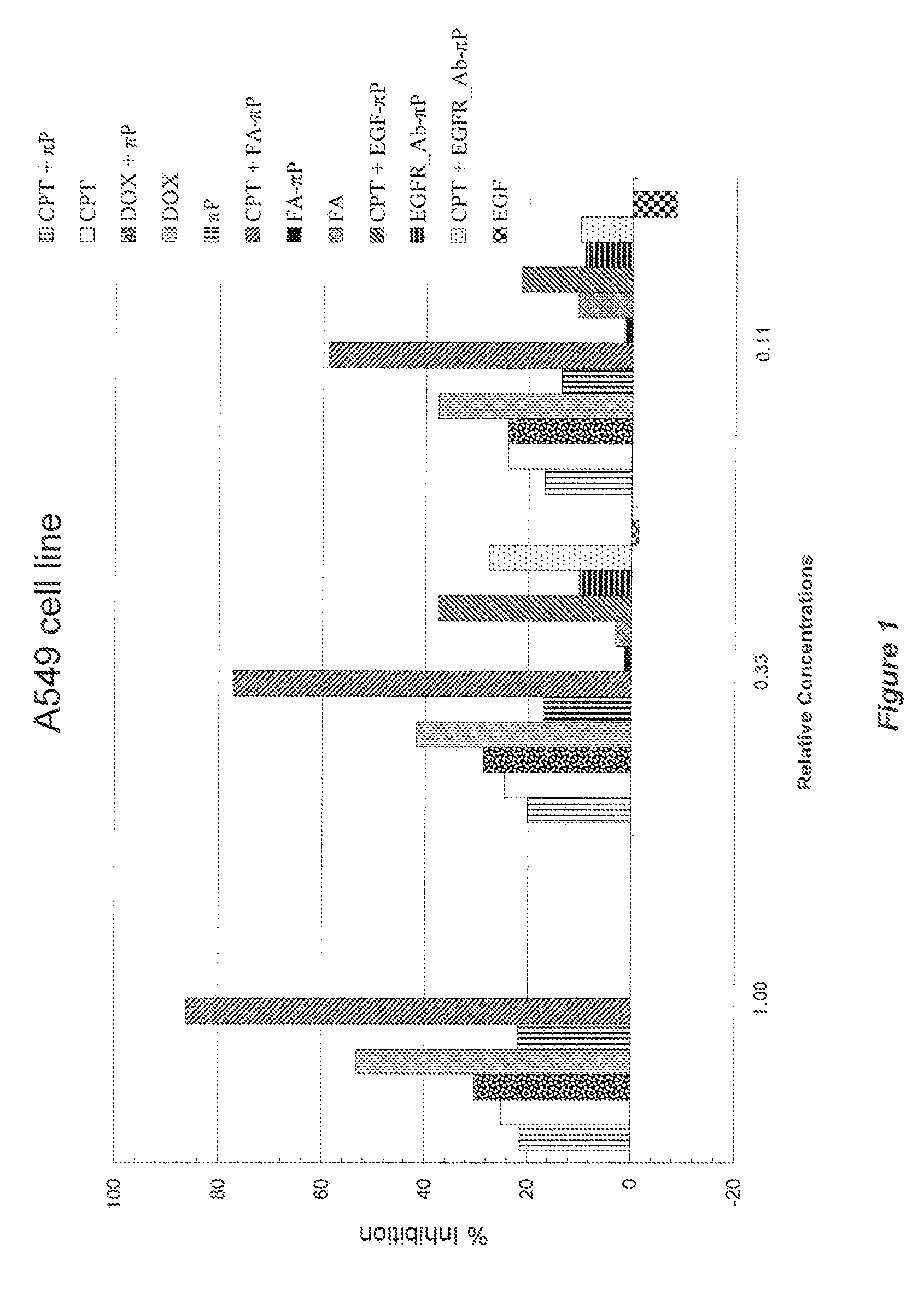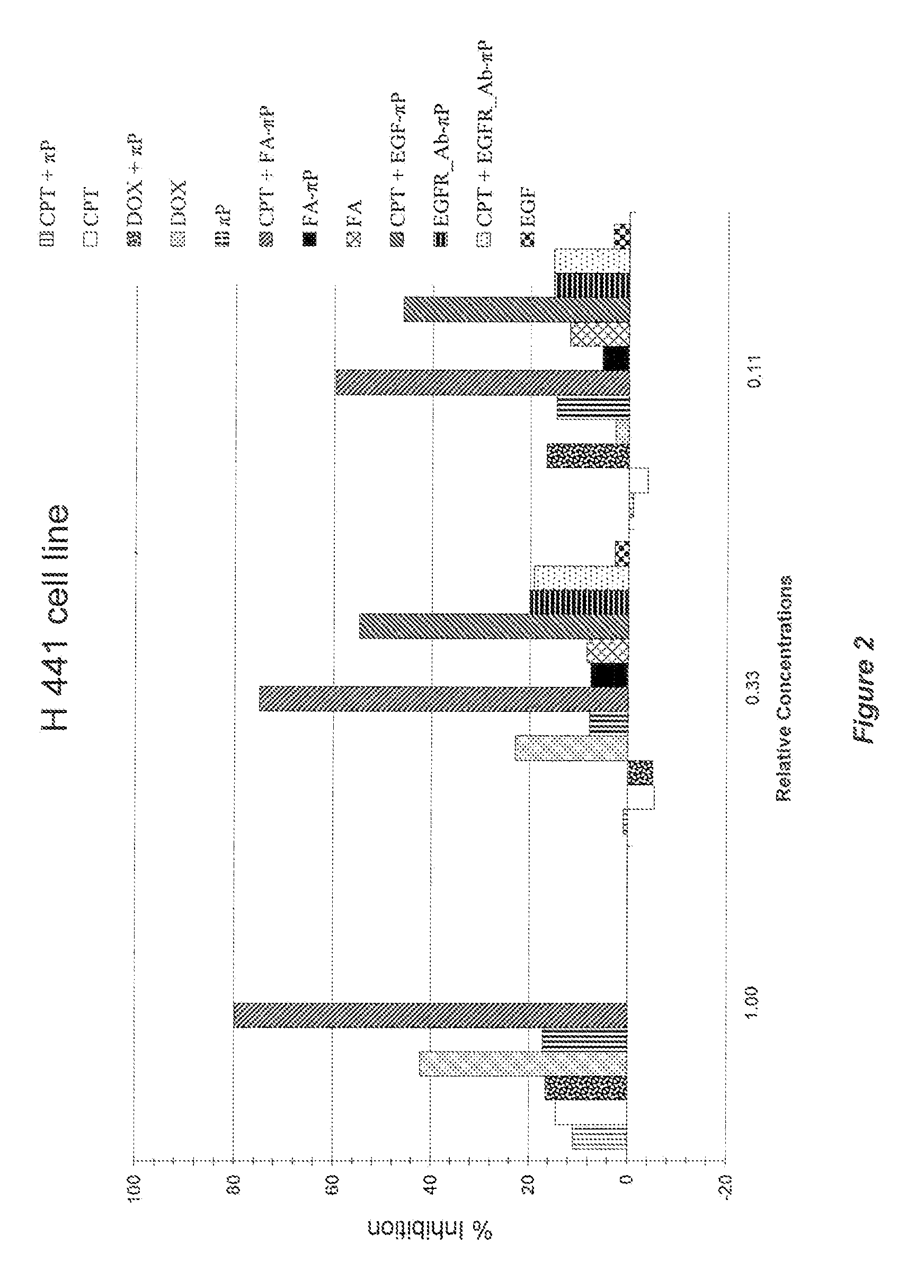Self-assembling amphiphilic polymers as Anti-cancer agents
a polymer and anti-cancer technology, applied in the field of amphiphilic polymers, can solve the problems of inability to attach targeting moieties such as antibodies or cell adhesion molecules to peg block copolymers, unable to kill cancer cells without damaging the patient's nearly-identical healthy cells, etc., and achieve the effect of efficient solubility, distribution and delivery of drugs
- Summary
- Abstract
- Description
- Claims
- Application Information
AI Technical Summary
Benefits of technology
Problems solved by technology
Method used
Image
Examples
example 5
PEG Copolymerization with EDTA dianhydride
[0115]Dry PEG is reacted with ethylenediaminetetracetic acid dianhydride by the method described in Example 1, and is then amidated with dodecylamine as in Example 1 or hexadecylamine as in example 3, or with the amines in examples 3a-3k.
[0116]In the same manner, the following dianhydrides are co-polymerized with PEG and subsequently amidated:[0117]Example 5a: Naphthalenetetracarboxylicdianhydride[0118]Example 5b: Perylenetetracarboxylicdianhydride[0119]Example 5c: Benzophenonetetracarboxylicdianhydride[0120]Example 5d: 4,4′-(Hexafluoroisopropylidene)diphthalic anhydride[0121]Example 5e: Butane tetracarboxylic acid dianhydride[0122]Example 5f: Bicyclo(2,2,2)oct-7-ene-2,3,5,6-tetracarboxylic dianhydride[0123]Example 5g: Diethylenetetramine Pentaacetic Acid Dianhydride[0124]Example 5h: 3,4,3′,4′-Diphenylsulfone tetracarboxylic acid dianhydride[0125]Example 5i: 3,4,3′,4′-Diphenyl ether tetracarboxylic acid dianhydride[0126]Example 5j: Pyromelli...
example 6a
PEG-diamine co-polymer with pendant thioethers
[0127]PEG dimaleate, prepared as in Example 1, is reacted with dodecanethiol (two equivalents per equivalent of PEG dimaleate) using the same procedure as used for DTT in Example 1. No dilution is necessary, as no polymerization takes place, and the reaction is conducted in molten PEG-dimaleate. The TEMED catalyst is added and then the thiol is added. The reaction is followed by the disappearance of starting materials, using TLC. Temperatures up to the point where the loss of alkylthiol by vaporization becomes significant can be employed (up to ca. 100° C.). A slight excess of alkylthiol may be employed to fully saturate the maleic groups. The excess alkylthiol is driven off at the end of reaction by sparging with nitrogen or argon, and / or heating under vacuum, until none is detected by odor or by TLC.
[0128]By this method, the following thiols may be conjugated to PEG dimaleate:[0129]Example 6Aa: mercaptosuccinic acid di-t-butyl ester[01...
example 6b
PEG-diamine co-polymer with pendant thioethers
[0141]
[0142]The thiol adduct obtained in Example 6A is amidated with 1,4-diaminobutane (one equivalent of diamine per two COOH groups), using the same procedure used for dodecylamine in Example 1, with dilution with water is as necessary to maintain the fluidity of the reaction mixture. Additional aliquots of EDC are added as necessary to ensure complete polymerization. By this method, the thiol adducts of Example 6A and 6Aa through 6Ak are converted to a PEG-diaminobutane polyamide.
[0143]By this method, the following diamines may be converted to a PEG polyamide (BOC=t-butoxycarbonyl):[0144]Example 6Ba: 2-(O-BOC)-1,3-diamino-2-propanol[0145]Example 6Bb: N′,N″-di(BOC) hexaethylene tetraamine[0146]Example 6Bc: N′,N″-di(BOC) spermine[0147]Example 6Bd: N′-BOC spermidine[0148]Example 6Be: N′,N″,N′″-tri(BOC) pentaethylene hexamine[0149]Example 6Bf: agmatine[0150]Example 6Bg: lysine t-butyl ester[0151]Example 6Bh: 1,6-diaminohexane[0152]Example...
PUM
| Property | Measurement | Unit |
|---|---|---|
| molecular weight | aaaaa | aaaaa |
| logP | aaaaa | aaaaa |
| pKa | aaaaa | aaaaa |
Abstract
Description
Claims
Application Information
 Login to View More
Login to View More - R&D
- Intellectual Property
- Life Sciences
- Materials
- Tech Scout
- Unparalleled Data Quality
- Higher Quality Content
- 60% Fewer Hallucinations
Browse by: Latest US Patents, China's latest patents, Technical Efficacy Thesaurus, Application Domain, Technology Topic, Popular Technical Reports.
© 2025 PatSnap. All rights reserved.Legal|Privacy policy|Modern Slavery Act Transparency Statement|Sitemap|About US| Contact US: help@patsnap.com



